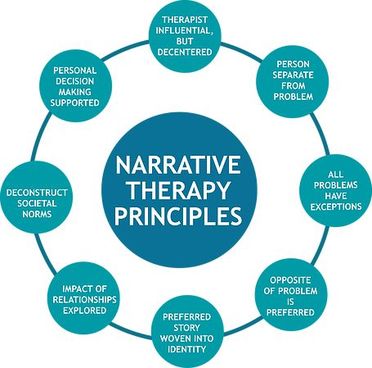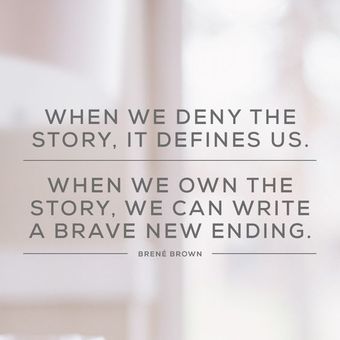 walkerwellness.com
walkerwellness.com
Way of Being:
Role of the counselor is collaborative and active facilitator. The counselor listens to the client’s stories respectively. "A main task of the therapist is to help clients construct a preferred story line" (Corey, 384).
Role of the client is active by exploring their preferred storyline, the problem, and actions that are taken to reduce the problem. The client is the expert of their life.
Role of the therapeutic relationship "Narrative therapist place great important on the values and ethical commitments a therapist brings to the therapy venture" (Corey, 385). The relationship is active and collaborative by using the client’s strengths and future focused.
Role of the counselor is collaborative and active facilitator. The counselor listens to the client’s stories respectively. "A main task of the therapist is to help clients construct a preferred story line" (Corey, 384).
Role of the client is active by exploring their preferred storyline, the problem, and actions that are taken to reduce the problem. The client is the expert of their life.
Role of the therapeutic relationship "Narrative therapist place great important on the values and ethical commitments a therapist brings to the therapy venture" (Corey, 385). The relationship is active and collaborative by using the client’s strengths and future focused.
 pranaschile.org
pranaschile.org
Ways of Understanding:
View of human nature the problem is not inherent within the client, but a product of, social, cultural, and political attributes. Clients interruptive begins and create their lives through stories. The client's language defines their reality. The therapist helps the client become aware of their competencies, strengths, and resources to construct a new storyline. By naming the emotions it adds validity to the emotion/problem.
View of the problem/maladaptive behavior: The client is stuck in problem thinking that burdens the client’s capability to limited perceptions. "Problems are manufactured in social, cultural, and political contexts" (Corey, 382).
View of healthy/adaptive behavior: Clients would recognize problems and externalize them, instead if internalizing the problem.
Goals of theory: "is to invite people to describe their experience in new and fresh language" (Corey, 384). This brings insight to the client about their feelings, problems, and behaviors. Using new language helps the client view the experience differently.
Key concepts: Narrative therapist avoid diagnosing and labels.
Assist with helping the client externalize the problem.
"Narrative therapy is a strengths-based approach that emphasizes collaboration between client and therapist to help clients view themselves as empowered and living the way they want" (Corey, 382).
The therapy changes with each client because each client is unique.
There is an emphasizes on language.
Narrative therapy believes it’s more important to show characteristics like Carl Rogers, than standard techniques.
Views of therapeutic change: The client is able to name and externalize the problem. The client has also become aware of their strengths and resources to be able to change their story.
View of human nature the problem is not inherent within the client, but a product of, social, cultural, and political attributes. Clients interruptive begins and create their lives through stories. The client's language defines their reality. The therapist helps the client become aware of their competencies, strengths, and resources to construct a new storyline. By naming the emotions it adds validity to the emotion/problem.
View of the problem/maladaptive behavior: The client is stuck in problem thinking that burdens the client’s capability to limited perceptions. "Problems are manufactured in social, cultural, and political contexts" (Corey, 382).
View of healthy/adaptive behavior: Clients would recognize problems and externalize them, instead if internalizing the problem.
Goals of theory: "is to invite people to describe their experience in new and fresh language" (Corey, 384). This brings insight to the client about their feelings, problems, and behaviors. Using new language helps the client view the experience differently.
Key concepts: Narrative therapist avoid diagnosing and labels.
Assist with helping the client externalize the problem.
"Narrative therapy is a strengths-based approach that emphasizes collaboration between client and therapist to help clients view themselves as empowered and living the way they want" (Corey, 382).
The therapy changes with each client because each client is unique.
There is an emphasizes on language.
Narrative therapy believes it’s more important to show characteristics like Carl Rogers, than standard techniques.
Views of therapeutic change: The client is able to name and externalize the problem. The client has also become aware of their strengths and resources to be able to change their story.
 creativityintherapy.blogspot.com
creativityintherapy.blogspot.com
Ways of Intervening:
Techniques: Questions- The counselor ask questions to provide dialoged and give clients opportunity to explore thoughts of their lives.
Externalization and Deconstruction- This technique is the most frequently borrowed. "This process separates the person from identification with the problem. When clients view themselves as "being" the problem, they are limited in the ways they can effectively deal with the problem. When clients experience the problem as being located outside of themselves, they can create a relationship with the problem" (Corey, 387).
Search for unique outcomes- during externalization the therapist asks questions to discover unique outcomes.
Alternative stories or Reauthoring- is a turning point for the client because the client makes the choice to change their story from the problem saturated one they have had.
Documenting the Evidence- It is important that the client has an audience that sees the change. The counselor may write a letter to the client that "provides a record of the session and may include an externalizing description of the problem and its influence on the client, as well as an account of the client's strengths and abilities that are identified in a session" (Corey, 389).
Multicultural considerations: Narrative therapy is considered culturally sensitive because it has characteristics of person centered therapy, such as unconditional positive regard, nonjudgmental, active listening, and the client is the expert. The client is able to construct their own story based on their perceptions, which may include their culture, social, and political views.
Population: The therapy would work best with individuals because the client can construct their own storyline. Having this therapy as individual will help the client focus on their own problems/ counseling issues.
Limitations: Some limitations of narrative therapy is since the therapy/techniques changes from client to client there is little evidence-based research done.
Techniques: Questions- The counselor ask questions to provide dialoged and give clients opportunity to explore thoughts of their lives.
Externalization and Deconstruction- This technique is the most frequently borrowed. "This process separates the person from identification with the problem. When clients view themselves as "being" the problem, they are limited in the ways they can effectively deal with the problem. When clients experience the problem as being located outside of themselves, they can create a relationship with the problem" (Corey, 387).
Search for unique outcomes- during externalization the therapist asks questions to discover unique outcomes.
Alternative stories or Reauthoring- is a turning point for the client because the client makes the choice to change their story from the problem saturated one they have had.
Documenting the Evidence- It is important that the client has an audience that sees the change. The counselor may write a letter to the client that "provides a record of the session and may include an externalizing description of the problem and its influence on the client, as well as an account of the client's strengths and abilities that are identified in a session" (Corey, 389).
Multicultural considerations: Narrative therapy is considered culturally sensitive because it has characteristics of person centered therapy, such as unconditional positive regard, nonjudgmental, active listening, and the client is the expert. The client is able to construct their own story based on their perceptions, which may include their culture, social, and political views.
Population: The therapy would work best with individuals because the client can construct their own storyline. Having this therapy as individual will help the client focus on their own problems/ counseling issues.
Limitations: Some limitations of narrative therapy is since the therapy/techniques changes from client to client there is little evidence-based research done.


